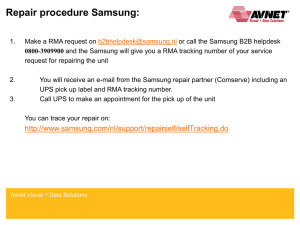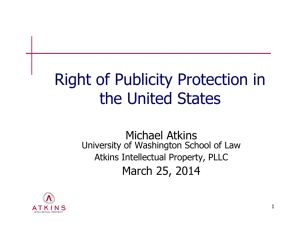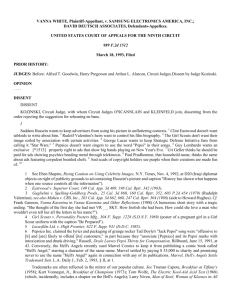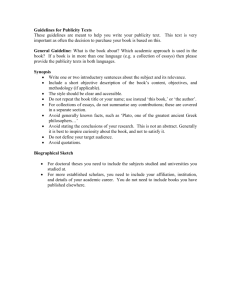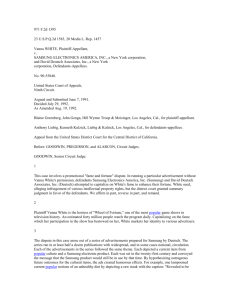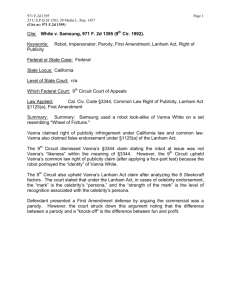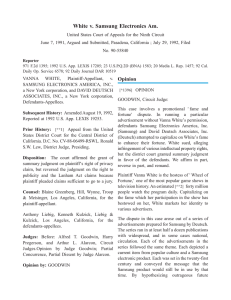White v. Samsung Electronics America, Inc.
advertisement
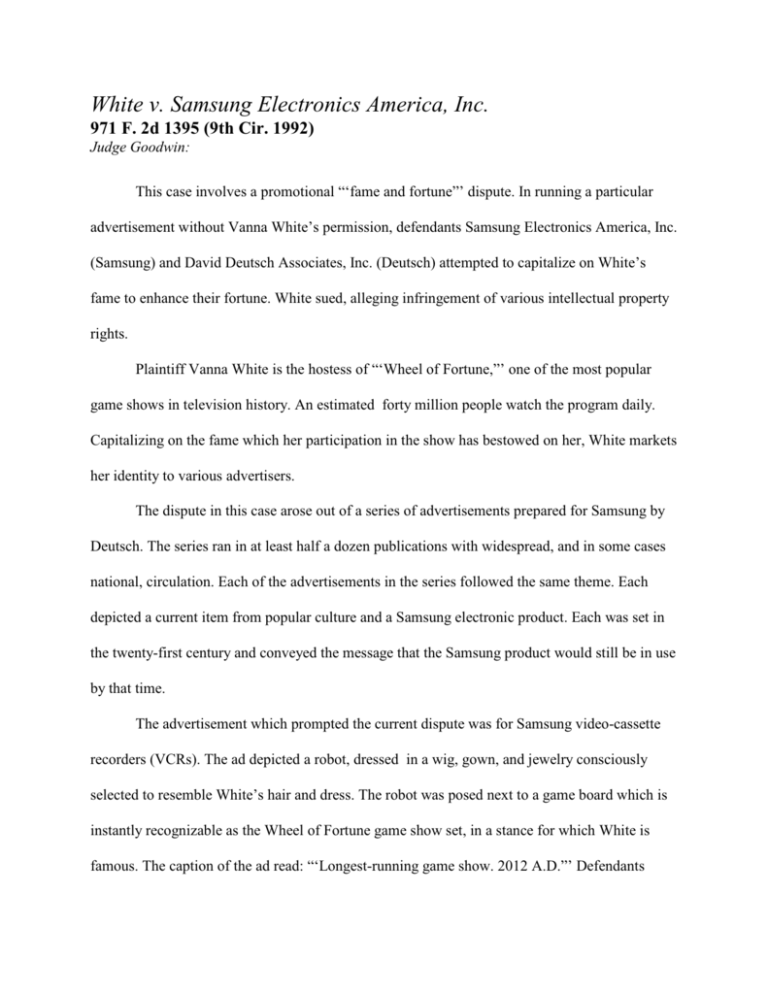
White v. Samsung Electronics America, Inc. 971 F. 2d 1395 (9th Cir. 1992) Judge Goodwin: This case involves a promotional “‘fame and fortune”’ dispute. In running a particular advertisement without Vanna White’s permission, defendants Samsung Electronics America, Inc. (Samsung) and David Deutsch Associates, Inc. (Deutsch) attempted to capitalize on White’s fame to enhance their fortune. White sued, alleging infringement of various intellectual property rights. Plaintiff Vanna White is the hostess of “‘Wheel of Fortune,”’ one of the most popular game shows in television history. An estimated forty million people watch the program daily. Capitalizing on the fame which her participation in the show has bestowed on her, White markets her identity to various advertisers. The dispute in this case arose out of a series of advertisements prepared for Samsung by Deutsch. The series ran in at least half a dozen publications with widespread, and in some cases national, circulation. Each of the advertisements in the series followed the same theme. Each depicted a current item from popular culture and a Samsung electronic product. Each was set in the twenty-first century and conveyed the message that the Samsung product would still be in use by that time. The advertisement which prompted the current dispute was for Samsung video-cassette recorders (VCRs). The ad depicted a robot, dressed in a wig, gown, and jewelry consciously selected to resemble White’s hair and dress. The robot was posed next to a game board which is instantly recognizable as the Wheel of Fortune game show set, in a stance for which White is famous. The caption of the ad read: “‘Longest-running game show. 2012 A.D.”’ Defendants referred to the ad as the “‘Vanna White”’ ad. Unlike the other celebrities used in the campaign, White neither consented to the ads nor was she paid. Following the circulation of the robot ad, White sued Samsung and Deutsch in federal district court under the California common law right of publicity. The district court granted summary judgment against White on each of her claims. White now appeals. The common law right of publicity cause of action may be pleaded by alleging (1) the defendant’s use of the plaintiff’s identity; (2) the appropriation of plaintiff’s name or likeness to defendant’s advantage, commercially or otherwise; (3) lack of consent; and (4) resulting injury. The district court dismissed White’s claim for failure to [establish that] defendants had appropriated White’s “‘name or likeness”’ with their robot ad. We agree that the robot ad did not make use of White’s name or likeness. However, the common law right of publicity is not so confined. The “‘name or likeness”’ formulation originated not as an element of the right of publicity cause of action, but [in Dean William Prosser’s famous ] description of the types of cases in which the cause of action had been recognized. It is not impossible that there might be appropriation of the plaintiff’s identity, as by impersonation, without the use of either his name or his likeness, and that this would be an invasion of his right of privacy. Since Prosser’s early formulation, the case law has borne out his insight that the right of publicity is not limited to the appropriation of name or likeness. The common law right of publicity reaches means of appropriation other than name or likeness; [moreover], the specific means of appropriation are relevant only for determining whether the defendant has in fact appropriated the plaintiff’s identity. The right of publicity does not require that appropriations of identity be accomplished through particular means to be actionable. The right of publicity has developed to protect the commercial interest of celebrities in their identities. The theory of the right is that a celebrity’s identity can be valuable in the promotion of products, and the celebrity has an interest that may be protected from the unauthorized commercial exploitation of that identity. If the celebrity’s identity is commercially exploited, there has been an invasion of his right whether or not his “‘name or likeness”’ is used. It is not important how the defendant has appropriated the plaintiff’s identity, but whether the defendant has done so. A rule which says that the right of publicity can be infringed only through the use of nine different methods of appropriating identity merely challenges the clever advertising strategist to come up with the tenth. Indeed, if we treated the means of appropriation as dispositive in our analysis of the right of publicity, we would not only weaken the right but effectively eviscerate it. The right would fail to protect those plaintiffs most in need of its protection. Advertisers use celebrities to promote their products. The more popular the celebrity, the greater the number of people who recognize her, and the greater the visibility for the product. The identities of the most popular celebrities are not only the most attractive for advertisers, but also the easiest to evoke without resorting to obvious means such as name, likeness, or voice. Viewed separately, the individual aspects of the advertisement in the present case say little. Viewed together, they leave little doubt about the celebrity the ad is meant to depict. The female-shaped robot is wearing a long gown, blond wig, and large jewelry. Vanna White dresses exactly like this at times, but so do many other women. The robot is in the process of turning a block letter on a game-board. Vanna White dresses like this while turning letters on a game-board but perhaps similarly attired. Scrabble-playing women do this as well. The robot is standing on what looks to be the Wheel of Fortune game show set. Vanna White dresses like this, turns letters, and does this on the Wheel of Fortune game show. She is the only one. Indeed, defendants themselves referred to their ad as the “‘Vanna White”’ ad. We are not surprised. Television and other media create marketable celebrity identity value. Considerable energy and ingenuity are expended by those who have achieved celebrity value to exploit it for profit. The law protects the celebrity’s sole right to exploit this value whether the celebrity has achieved her fame out of rare ability, dumb luck, or a combination thereof. We decline Samsung and Deutsch’s invitation to permit the evisceration of the common law right of publicity through means as facile as those in this case. Because White has alleged facts showing that Samsung and Deutsch had appropriated her identity, the district court erred by rejecting, on summary judgment, White’s common law right of publicity claim. Points for Discussion 1. If a group of comics, such as NBC’s Saturday Night Live cast, wanted to make fun of Vanna White’s on-air persona, they could surely imitate White visually and vocally far more closely than the Samsung robot did, yet they would not have to ask White’s permission to do the sketch. If Samsung’s purpose in creating the Vanna White commercial was also to make fun of the game show co-host, should their ultimate purpose of selling VCRs count against them? 2. Judge Goodwin claims that Samsung appropriated White’s “‘identity”’ by creating a robot with the physical proportions of an attractive woman, posed gracefully, dressed in a blond wig, an evening gown, and jewelry. But are not these characteristics of countless numbers of young women in the entertainment industry? Is not the only feature of the commercial that is uniquely attributable to White the replication of the Wheel of Fortune set (to which, presumably, she does not own the rights)? Why, then, should White be able to sue for damages for Samsung’s “‘taking”’ from her that which never belonged to her?


